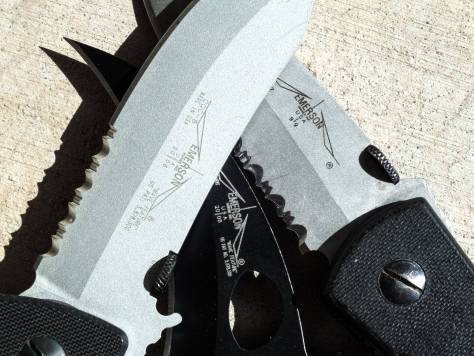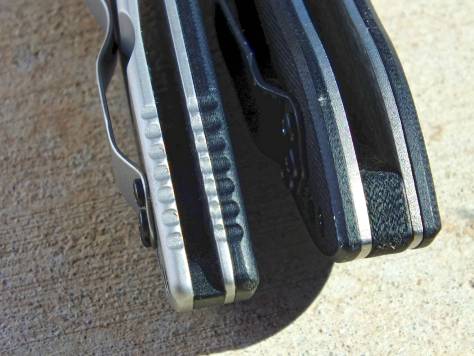Emerson Knives: A Critical Look
Emerson Knives Inc. and the custom knives of Ernest Emerson enjoy a strong reputation in professional circles. Emerson folding knives in particular are considered by many to be the epitome of what tactical knives should be. I was an Emerson user (hard user) and fan for over a decade, beginning in 2001. I owned both production and custom Emerson folding knives. And after selling off all of them, I am not likely to buy another one.

I gave up on Emerson for a few reasons:
- Under-functional blade grinds: Many Emerson designs feature asymmetric primary bevels, and most utilize a chisel-ground edge bevel. Combined with very obtuse primary bevels, this asymmetry decreases cutting performance. Over time, getting experience with less-obtuse and more even grinds on other knives, the increased drag and less acute edges of my Emerson’s lead me to use them less and less.
- Poor workmanship and bad quality control: Every Emerson production folder I have owned had poor scale to liner fit, and badly finished liners (rough edges barely broken on a sanding belt after cutting out). A few I owned and many I’ve handled have had gritty or sloppy actions, from roughly finished contact surfaces and pivot screws that either backed out in use or simply weren’t fitted properly. Several have also had bad heat treatments, mostly the steel having been heat-treated too hard, making it difficult to sharpen (compared to peers in the same steel), or so hard that the edge would chip away during sharpening.

The arrow indicates small chips from the edge that occur during sharpening on this CQC-7A, and many other Emerson Knives, as a result of over-hardening during heat treatment. - Poor construction choices: Primarily this is the utilization of thin liner locks in the majority of offerings. Due to the thinness of the liners, they wear overly fast and need replacement regularly (I have replaced several liners on Emerson knives, and had two fail resulting in injury). Many knives experience these problems, but most competitors to Emerson have moved to very thick liners, frame-locks and other locking mechanisms, due to the inherent issues in thinner liner locks.

The lockside liner from the Emerson Super Karambit shows the rough internal finishing common to Emerson Knives. The liner is smoothed at a rough grit, and then barely smoothed at a higher grit, resulting in a rough surface on which the action washers ride. - Decline in quality over the years, in what was already a very up-and-down quality situation: Even back in the early days of production Emerson knives, it was recognized that some years were worse than others and we Emerson fans avoided those years when buying knives on the secondary market. Over time, the issues I experienced as an Emerson user, have seemed to only get worse. The fitment has gotten worse on both production and custom knives. Badly finished liner edges, poor fit between liners and scales, cross-threaded screws, and gritty actions are all common on Emerson production knives. The customs too exhibit worse fitment between scales and bolsters, and gritter actions, than mine ever did. I had an early 2000’s CQC7 custom that wasn’t perfect, but had a smooth action and working fitment between components. I sold that knife to fund other projects, and intended to replace it when I could, but after handling the newer customs, I walked away entirely.

The finger-ring on the Super Karambit shows the very rough edge finishing regularly seen on Emerson Knives. In high contact areas, such as the finger-ring, this rough finish can cause soft tissue damage. 
The rough finish seen in the karambit’s ring, is continued around all the exposed edges of the liners. 
Holding many Emerson knives up to the light, reveals that the scales do not fit flush against the liners. This can be clearly seen here, on the Super Karambit. 
An end-shot of the CQC-8 displays the rough finish and uneven alignment between scales, liners and backspacers often seen on Emerson Knives.
- Similarly, after years with an Emerson production knife in my pocket, I got tired of the repeated liner replacements, less functional blade grind, and overall roughness. My last Emerson was a Commander, purchased in 2002 and finally sold in 2014 at which point it was on it’s third or fourth liner (and that one needed replaced) and was missing two grip-screws after Emerson service had cross-threaded them doing a liner replacement, causing them to strip during later cleaning. To extend the life of the liner, I’d had the engagement surfaces of the liner-lock and the tang of the blade carbidized with tungsten carbide, and had still had to use a punch to stretch the liner to attain solid lockup.
Emerson has some very fine designs. My initial attraction to, and long fandom of, Emerson knives was all about the designs. But the quality of the product overall, has not lived up to the designs in my long history with the knives. For what an Emerson costs? That is unacceptable. There are better knives, for less money, or the same money. Knives with better fit and finish, better workmanship, stronger craftsmanship, better edges and bevels, better heat treatment, and modern locking systems that don’t wear out as rapidly.




The best thing Emerson knives has given professional users of folding knives is the “Wave” feature, the hook behind the thumb-opener that catches the users pocket opening the knife on the draw. For a folding knife to begin to receive serious consideration as a defensive tool, this feature is a must have. And yet, even that is better executed by other companies, such as Spyderco, who make the hook more pronounced and deeper for more positive engagement on the pocket-lip, for more reliable opening. It is a boon to users that both the Wave feature, and Emerson designs, are available from other manufacturers. Kershaw has a very functional line of budget Emerson designs, with far better fit and finish than the price suggests, the Wave feature, and stainless-steel frame locks. Zero Tolerance, a sibling company to Kershaw, also produces very high quality Emerson designed frame-locks, that are better quality than Emerson themselves, for the same price. While producing no Emerson designs, Spyderco also licenses the Wave feature for several very good quality knives, including the classic working folders the Endura and Delica, and the impeccable P’Kal defensive knife.




I was a die-hard Emerson fan for a decade. Over the years, I owned around $3000 worth of Emerson knives, production and custom, and made heavy use of them in daily carry in every walk of my life. Over time, the attraction of the good designs and the Wave feature finally faded under the glare of function-affecting quality and construction issues. There is not another Emerson knife in my future.








[…] Emerson Knives: A Critical Look […]
[…] Finally, certain knife friends have indicated to me that if you want an Emerson, the Kershaws may actually be your best bet; apparently some of the QC on the official Emerson stuff has been… lacking in recent years. […]